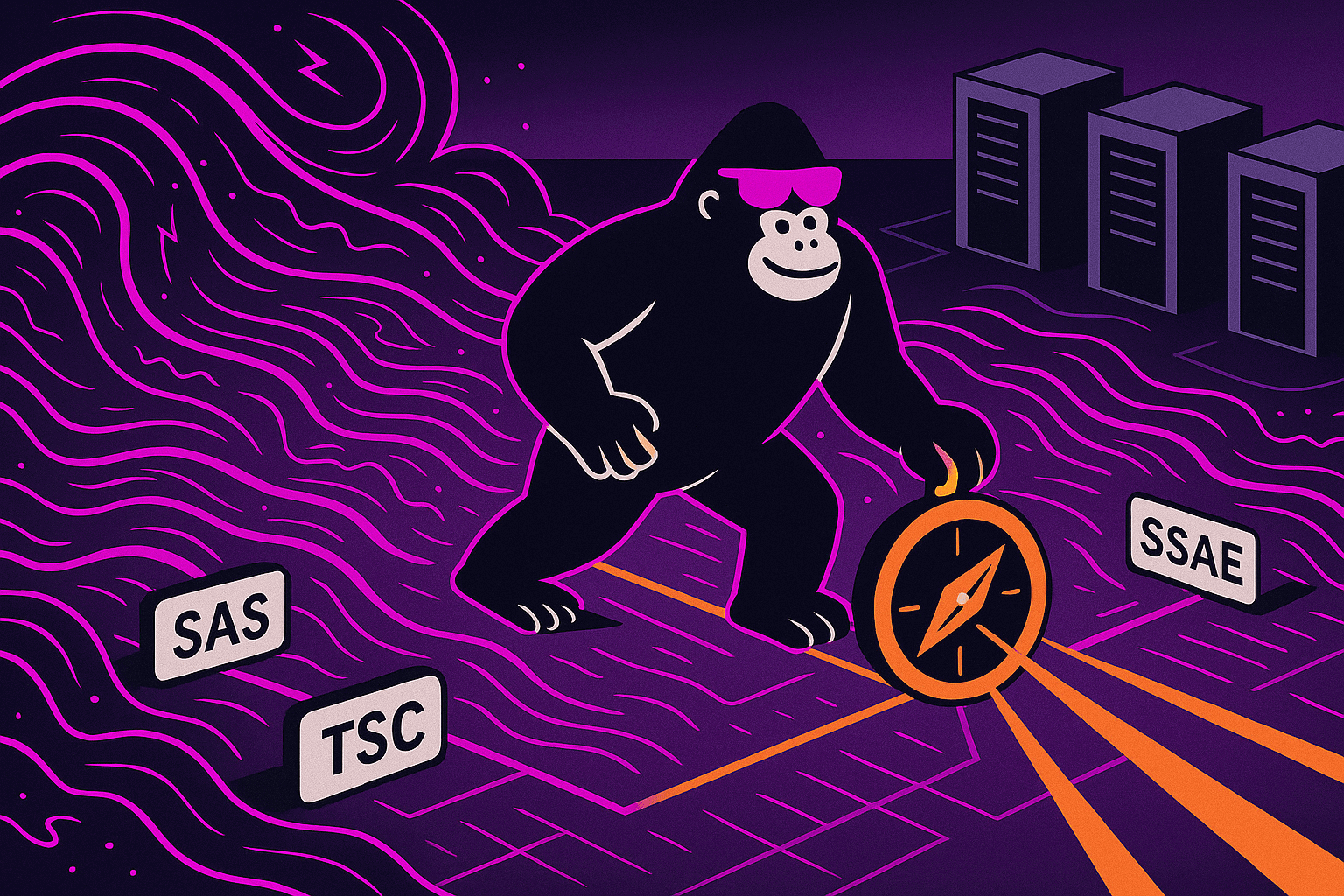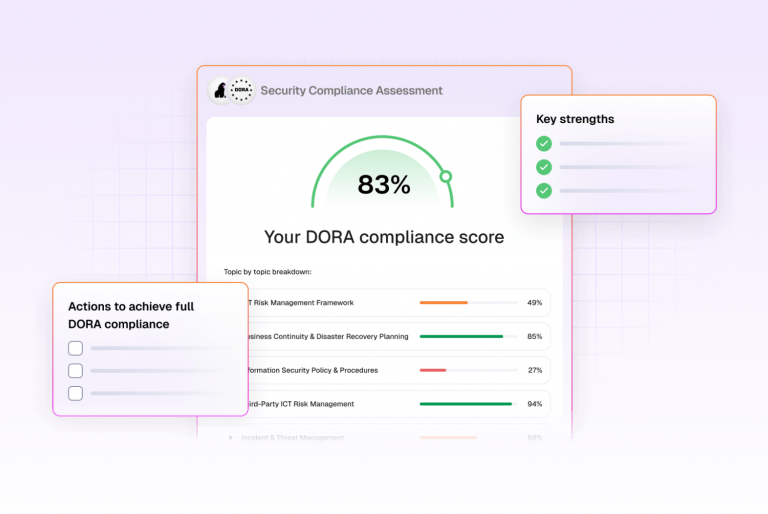Picture this: You’re sitting in a boardroom at 3 PM on a Tuesday, and your biggest prospect just asked, “Do you have SOC compliance?” You confidently respond, “Absolutely!” Then comes the follow-up punch: “Great, we need SOC 1.” Your heart sinks because you spent the last eight months getting SOC 2 certified. I wish I could tell you this scenario is fictional, but I’ve watched this exact conversation unfold more times than I care to count during my 21 years in the trenches of IT and compliance.
Here’s the thing about SOC reports—they’re like ordering coffee in a specialty café. You think you’re asking for something simple, but suddenly you’re faced with choices you didn’t know existed, and picking the wrong one leaves everyone unsatisfied. The difference between SOC 1 and SOC 2 isn’t just academic trivia for compliance nerds like me; it’s the difference between building trust with your stakeholders and wasting months of effort on the wrong attestation framework.
This deep dive will help you navigate the SOC landscape without falling into the common traps that I’ve seen derail countless organizations. We’ll explore what makes these frameworks tick, when to choose which path, and how to avoid the expensive mistakes that keep me busy consulting for companies who got it wrong the first time.
When auditors speak different languages
SOC 1 and SOC 2 solve completely different problems for completely different people. It’s like the difference between a cardiologist and a dermatologist—both are doctors, but you wouldn’t ask your dermatologist for blood pressure medication.
SOC 1 lives in the world of financial reporting accuracy. It asks one simple question: “If something goes wrong with your service, could it mess up your customer’s financial statements?” The auditors want to see controls around transaction processing, data accuracy, and proper authorization. They care about your fancy network security only if a breach could corrupt financial data.
SOC 2 is the security team’s framework, built around five Trust Services Criteria that prove you won’t lose, leak, or mangle customer data. The beauty is its flexibility, you can pick which criteria apply to your business. A cloud storage provider might focus on security and availability, while a healthcare processor would need all five criteria.
| Aspect | SOC 1 | SOC 2 |
| Primary focus | Financial reporting accuracy | Data security and operations |
| Key question | “Could this impact financial statements?” | “Can we trust you with our data?” |
| Target audience | Financial auditors, accounting teams | Customers, partners, regulators |
| Control scope | Transaction processing, financial accuracy | Security, privacy, system reliability |
| Flexibility | Fixed on financial processes | Customizable across five criteria |
| Regulatory alignment | Sarbanes-Oxley compliance | GDPR, HIPAA, PCI DSS |
PRO TIP
Maintain a simple reference matrix in your GRC tool that maps each audience (e.g. finance, security, legal) to the appropriate SOC report. At a glance, you—and your sales team—will know which attestation to propose.
Type I versus Type II: The choice that actually matters
Both frameworks offer Type I (design assessment) and Type II (operational effectiveness) options. Type I is like taking a photograph—it shows your controls look good on paper at a specific moment. Type II is like making a documentary—it proves your controls actually work consistently over 6-12 months.
The market perception difference is dramatic. I’ve had customers say, “Anyone can write good policies. We want to know if you can execute them consistently.” Type II answers that question, which is why it carries significantly more weight with stakeholders despite requiring more time and money.
| Characteristic | Type I | Type II |
| Assessment scope | Control design only | Design + operating effectiveness |
| Time period | Point-in-time snapshot | 6-12 months of operation |
| Market credibility | Moderate | High |
| Audit complexity | Lower | Higher |
| Preparation time | 3-6 months | 6-12 months |
PRO TIP
If you choose Type II, kickoff a quarterly test plan review: map each control to a test month (e.g. access review in January, change-control in April). That cadence ensures you gather six to twelve months of evidence without a last-minute scramble.
Choosing your compliance path without losing your sanity
The decision between SOC 1, SOC 2, or both comes down to understanding your stakeholders’ actual needs. I learned this the expensive way when a client spent six months preparing for SOC 2, only to discover their biggest customer needed SOC 1 for financial reporting requirements.
| Business Type | Choose SOC 1 | Choose SOC 2 | Consider Both |
| Payroll processing | ✓ | Maybe | If hosting complex IT |
| Cloud storage | Rarely | ✓ | If handling financial data |
| Financial software | ✓ | Maybe | If SaaS-based |
| Banking platforms | Maybe | ✓ | ✓ |
| Healthcare tech | Rarely | ✓ | If processing payments |
| General SaaS | Rarely | ✓ | If financial use cases |
Choose SOC 1 only if your services exclusively impact customer financial reporting. This applies to payroll processors, accounts receivable managers, or financial software providers where data security isn’t the primary stakeholder concern.
Most technology companies need SOC 2. Your customers want assurance about data protection, system availability, and information handling. The flexibility to select relevant Trust Services Criteria makes it ideal for diverse customer requirements.
Organizations offering financial services in complex IT environments often need both. A core banking platform might need SOC 1 for transaction processing compliance and SOC 2 for data security assurance. Different stakeholders, different requirements.
SOC 1 vs. SOC 2: The implementation reality check
Most organizations underestimate SOC preparation by about 50%. Companies with mature controls might complete SOC 2 Type I in 3-4 months, but those starting from scratch often need 8-12 months just to design and implement adequate controls.
Cost varies dramatically. SOC 1 audits are more predictable because the scope is well-defined. SOC 2 costs range from $15,000 for simple applications to over $100,000 for complex platforms, depending on which Trust Services Criteria you select and your infrastructure complexity.
| Factor | SOC 1 | SOC 2 |
| Typical preparation time | 4-8 months | 6-12 months |
| Initial audit cost range | $20,000-$60,000 | $15,000-$100,000+ |
| Annual maintenance cost | 40-50% of initial | 50-60% of initial |
| Internal resource requirement | 0.5-1 FTE | 1-2 FTE |
| Control complexity | Moderate | High (varies by criteria) |
| Documentation burden | Heavy | Very heavy |
The hidden cost that catches everyone: ongoing maintenance. SOC reports require continuous monitoring, evidence collection, and annual renewals. Budget at least 50% of your initial implementation cost annually for maintenance. This isn’t a project—it’s a permanent program.
PRO TIP
Track your internal SOC effort in full-time equivalent (FTE) hours. Logging actual hours against controls helps you forecast resource needs for next year’s maintenance budget (usually 50–60% of initial).
When compliance becomes competitive advantage
The organizations that approach SOC strategically consistently outperform peers in customer acquisition and operational efficiency. SOC reports provide independent validation that builds credibility in ways internal assessments cannot match. In competitive situations, having the right attestation often determines who makes the vendor shortlist.
The audit process identifies control gaps before they become incidents. During one engagement, we discovered a client’s backup procedures weren’t working—they’d been backing up corrupted data for months. The audit potentially saved them from catastrophic data loss.
Most importantly, SOC frameworks force operational discipline that pays dividends across all business aspects. Companies successfully implementing SOC typically see improvements in efficiency, accountability, and customer satisfaction.
Streamline your SOC 2 compliance with CyberUpgrade
SOC 2 compliance demands airtight controls, clear evidence, and proof that your security measures truly work under scrutiny. CyberUpgrade offers predefined, customizable workflows aligned with Trust Services Criteria that automate tasks like background checks, access reviews, and incident logging. Real-time Slack and Teams prompts guide your team through every step, slashing manual effort by up to 80% and ensuring no control gets overlooked.
All compliance evidence—from vulnerability scans to MFA logs—is centralized in an audit-ready repository, making it easy to satisfy both ongoing monitoring and “separate evaluation” requirements under CC 4.1 and CC 7.1. Built-in risk assessments, pen-testing integrations, and continuous monitoring shore up your defenses, while our fractional CISO service provides expert guidance and strategic leadership.
With CyberUpgrade, you’ll not only meet today’s SOC 2 standards but build a scalable, future-proof compliance program—so audits become confirmation, not chaos.
Your strategic compliance roadmap
The question isn’t whether you need SOC attestation—it’s which framework serves your stakeholders’ needs and strategic objectives. Start with honest stakeholder conversations about their actual requirements, not assumptions about what they need.
SOC compliance is a journey, not a destination. Build flexibility into your program from the beginning and view each audit cycle as an opportunity to improve operations, not just maintain certification. The companies that approach SOC strategically, with proper planning and realistic expectations, consistently achieve better outcomes than those treating it as a checkbox exercise.
Your future customers, investors, and partners will thank you for getting it right the first time.









